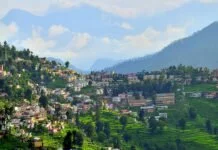Mussoorie is often called Mansoorie by the locals after ‘Mansoor’, a local shrub that is indigenous to this area. The town was also known as the first place where the 14th Dalai Lama arrived in India after the Tibetan Rebellion of 1959. He established the central administration in Mussoorie before moving toDharamsala in the state of Himachal Pradesh. The Tibetan school was also established in 1960 leading to the establishment of the Tibetans in Happy Valley which is a must visit place.
Located in the foothills of the Garhwal Himalayas and its high elevation, Mussoorie enjoys a highland climate. The summers are mild and pleasant and the winters are chilly with snowfall. The summer months between April and June see the maximum temperatures that never go beyond 25 degrees Celsius. The months between July and September receive a heavy amount of rainfall. The months starting from October till February mark the winter months which can see snowfall and low temperatures upto 2 degrees and below.
Mussoorie is best visited after the monsoons retreat as the region is prone to floods and landslides during the rainy season. The winter months starting from October see the most pleasant of climates and festivities. The town is known for its romantic views and is quiet popular as a honeymooning hotspot. Although for people who like to get the best out of Mussoorie should visit the place between mid February and mid April.
Attractions/Things to Do
With its varied flora and fauna and the views of the snow capped Himalayan peaks, the green hills of Mussoorie are a perfect destination to escape the scorched low lying plains. It is often described as the Queen of the hills due to its romantic surroundings. The center of all tourist activities in Mussoorie is definitely the central promenade known simply as the Mall. The famous nature walk of the Camel’s back road is an activity that must be experienced to enjoy the views of the mountains that surround the hill town. Hills, waterfalls, old churches, Tibetan colonies with temples and cafes, lakes, gardens are few of the numerous attractions that the town enshrines.
Nahata Estate, Gun Hill, Kempty Falls, Lake Mist, Bhatta Falls, Mussoorie Lake, Jharipani Falls, Sir George Everest’s House, Cloud’s end, Lal Tibba, Tibetan Buddhist Temple, Eco Park and Library etc. are the various places every tourist must visit in Mussoorie.
Being a famous hill town located in the Dehradun district of the state of Uttarakhand, it is well connected with the rest of the places via roads and railways. Buses can be taken via Dehradun along with taxis that can charge upto INR 1000 with additional Rs.50 as the night charges. Shared Taxis are also available and the transit usually takes around 90 minutes from Dehradun to Mussoorie. The Jolly Grant Airport in Dehradun is the nearest airport with flights available via Delhi. Dehradun is again the nearest railway station with several trains available from all major railway stations in India, via Delhi.
1. Dehradun – 30 kilometers
2. Haridwar – 80 kilometers
3. Rishikesh – 72 kilometers
4. Almora – 397 kilometers
5. Chandigarh – 200 kilometers
6. Shimla – 257 kilometers
7. Delhi – 267 kilometers
8. Lucknow – 574 kilometers
9. Jaipur – 533 kilometers
10. Ahmedabad – 1200 kilometers
11. Kolkata – 1,582 kilometers
12. Mumbai – 1,670 kilometers
13. Hyderabad – 1,775 kilometers
14. Bangalore – 2,365 kilometers
15. Chennai – 2400 kilometers
To enjoy and get the best out of Mussoorie, it is best that you travel on foot. The mall is closed for vehicles up to 10 PM. Rickshaws and taxis can be taken to get to places that are located outside the town. Buses can also be taken from the Kempty bus stand to reach the famous Kempty falls. Being a tourist town, Mussoorie is famous for its luxury hill resorts since the British raj and one can find plenty of places to put up that fit every kind of tourist budget.







